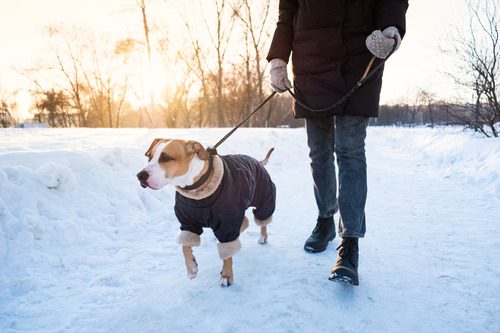When temperatures drop in Acworth, many pet owners start asking the same question: When is it too cold to walk your dog? Winter walks offer exercise and stimulation, but there’s a point when the cold can do more harm than good. While some dogs handle chilly weather better than others, it’s important to understand how temperature, wind chill, and your dog’s breed all play a role. This blog will explore the signs that it may be too cold so you can make informed decisions that protect your dog’s comfort and health during the colder months.

Understanding Your Dog’s Cold Tolerance
Dogs react to cold differently, depending on their breed, size, age, and overall health. While some are built for the cold, others may struggle even in slightly chilly weather.
Breed and Coat Type Matter
A dog’s breed is one of the most important factors in determining cold tolerance. Breeds with thick, double-layered coats such as Siberian Huskies, Alaskan Malamutes, and Bernese Mountain Dogs often enjoy brisk walks even in freezing weather. These dogs were bred for colder climates and tend to have natural insulation. In contrast, short-haired breeds like Greyhounds, Boxers, and Chihuahuas don’t have that extra layer of warmth. These dogs may start to feel uncomfortable when temperatures drop below 45°F. If you’re wondering when is it too cold to walk your dog and you have a short-coated or small-breed dog, the answer may come sooner than you expect.
Age, Size, and Health Factors
Puppies, senior dogs, and those with chronic health conditions are more sensitive to the cold. Their immune systems and internal regulation may not be as strong, making them less able to tolerate lower temperatures. Smaller dogs also lose body heat more quickly due to their size. If your dog fits into one of these categories, you should be cautious about walking in temperatures under 50°F. Be especially mindful when the wind picks up or when the ground is wet or icy.
Safe Temperature Ranges for Dog Walks
As a general rule, temperatures above 45°F are safe for most healthy dogs. Once the mercury drops below that point, you’ll want to pay closer attention.
Recognizing Temperature Thresholds
- Above 45°F: Safe for all dogs. Dress appropriately and keep an eye out for snow, ice, or salted roads.
- 32°F – 45°F: Small breeds, senior dogs, and short-haired dogs may need extra protection or shorter walks.
- 20°F – 32°F: Use caution. Consider a coat or boots for dogs sensitive to the cold. Limit time outside.
- Below 20°F: This is when it’s too cold for many dogs to walk, especially smaller or vulnerable ones. Focus on quick potty breaks.
- Below 10°F: Walking your dog may pose risks even for cold-weather breeds. It’s best to stay indoors.
Even with these guidelines, always watch your dog’s behavior. If they start lifting their paws, shivering, or refusing to move forward, it’s likely too cold to continue.
Wind Chill and Moisture: Hidden Cold Risks
Air temperature alone doesn’t tell the whole story. Wind and moisture can make conditions much worse, lowering your dog’s effective body temperature and increasing the risk of frostbite or hypothermia.
Wind Chill’s Impact
Wind chill strips away body heat, making it feel much colder than the thermometer says. A calm 25°F might be tolerable, but a windy 25°F can be uncomfortable and even dangerous. Dogs with short coats or exposed skin are especially vulnerable.
Wet Fur Equals Faster Heat Loss
If your dog’s coat gets wet from snow or rain, they’ll feel the cold much more quickly. Damp fur loses its insulating ability, and the added chill can cause their body temperature to drop rapidly. When walking during snow or sleet, always dry your dog thoroughly afterward and keep walks brief.
Signs It’s Too Cold for Your Dog
Even with temperature guidelines, your dog will give you the clearest signals. Paying attention to their behavior can help you decide when it’s too cold to walk your dog. These may include:
- Shivering or trembling
- Lifting or licking paws
- Refusing to walk
- Whining or barking
- Hiding behind you or burrowing in snow
Any of these behaviors mean it’s time to cut the walk short. Always trust your dog’s instincts—they often know when it’s too cold before you do.
How to Protect Your Dog During Cold Walks
If your dog still enjoys time outside during winter, you can make walks safer and more comfortable with a few adjustments.
Dress for the Weather
Dogs that struggle with the cold benefit from extra layers. Coats and sweaters can help retain body heat, especially for short-haired or small dogs. Make sure the clothing fits snugly but comfortably and doesn’t restrict movement. Boots protect your dog’s paws from snow, ice, and road salt, which can cause irritation or cuts. If your dog resists boots, try a protective balm to create a barrier against cold surfaces.
Choose the Right Time and Place
Walk your dog during daylight hours when it’s warmer and less icy. Stick to cleared sidewalks or paths where your dog is less likely to encounter salted roads or frozen puddles. Avoid walking near bodies of water that may be iced over. Dogs can easily fall through thin ice, which can be extremely dangerous in frigid conditions.
Indoor Alternatives for Cold Days
Sometimes the answer to when is it too cold to walk your dog is: right now. When it’s unsafe to head outdoors, indoor play can provide exercise and mental stimulation. Potential indoor activities include the following:
- Tug-of-war: Burns energy and strengthens your bond.
- Fetch in a hallway or basement: Great for short bursts of cardio.
- Interactive toys and puzzles: Keeps your dog’s brain engaged.
- Training games: Practice commands or teach new tricks.
When Should You Call Mills Animal Hospital?
If your dog shows signs of frostbite or hypothermia—such as pale or gray skin, extreme lethargy, or difficulty walking—call us at (770) 903-5995. While many cold-related issues can be avoided with careful monitoring, it’s always best to check in if you notice something unusual after a winter walk. Have questions about how your dog handles colder weather or need tips on safe winter outings? Our team at Mills Animal Hospital in Acworth is happy to help. Every dog is different, and we can offer guidance based on your pet’s breed, age, and health history.
